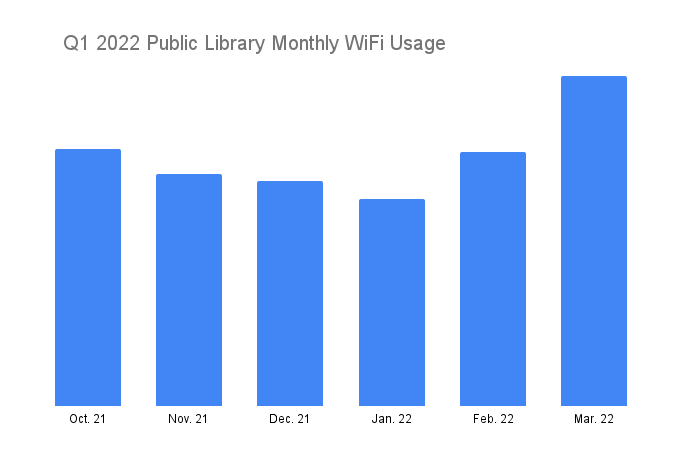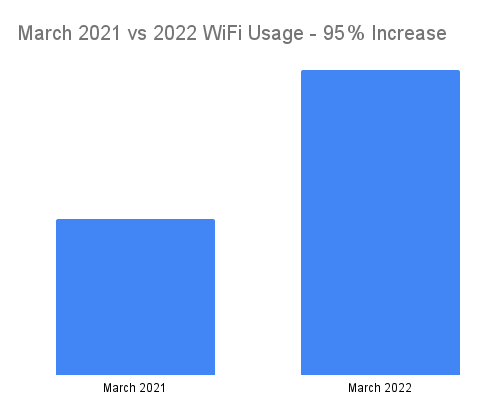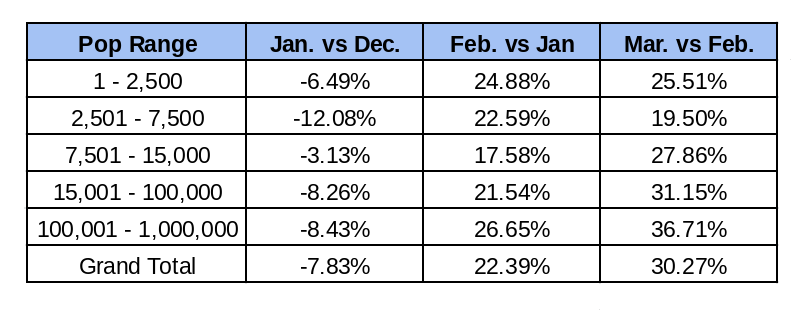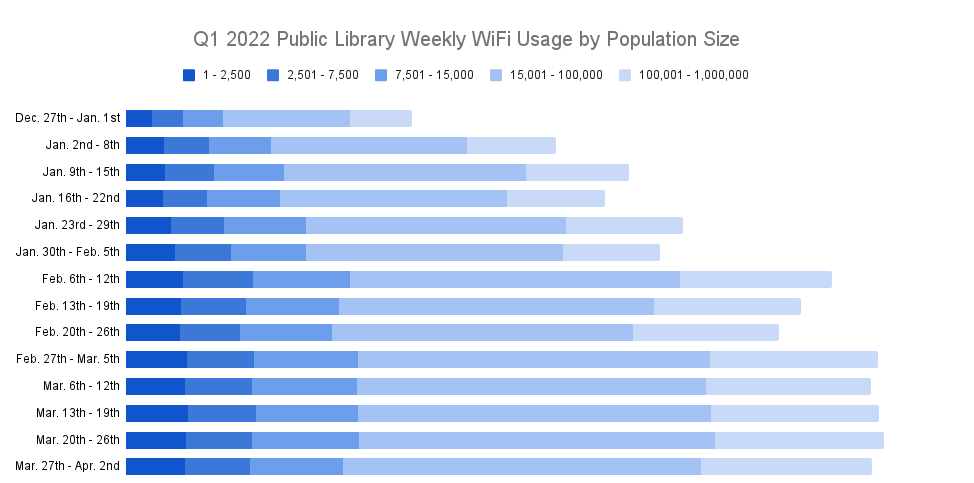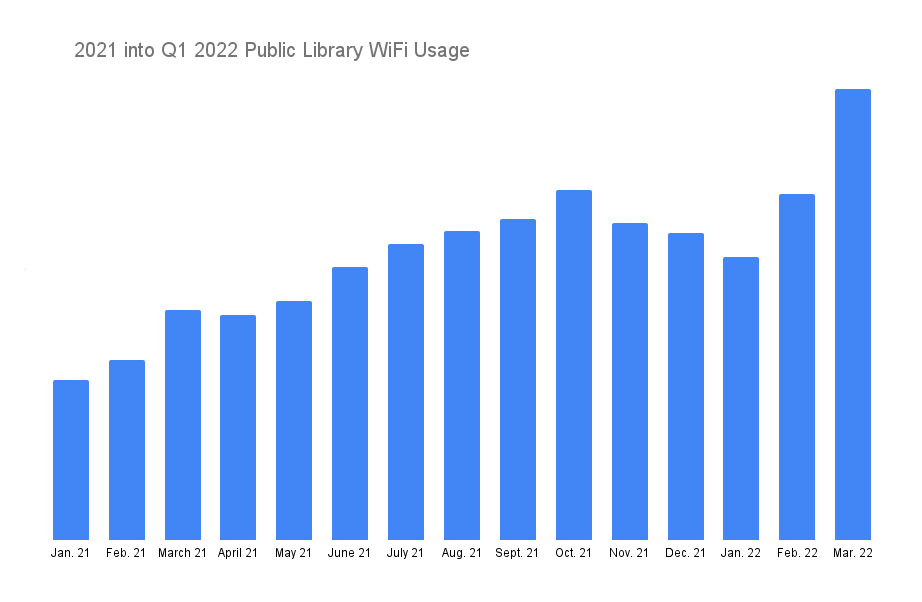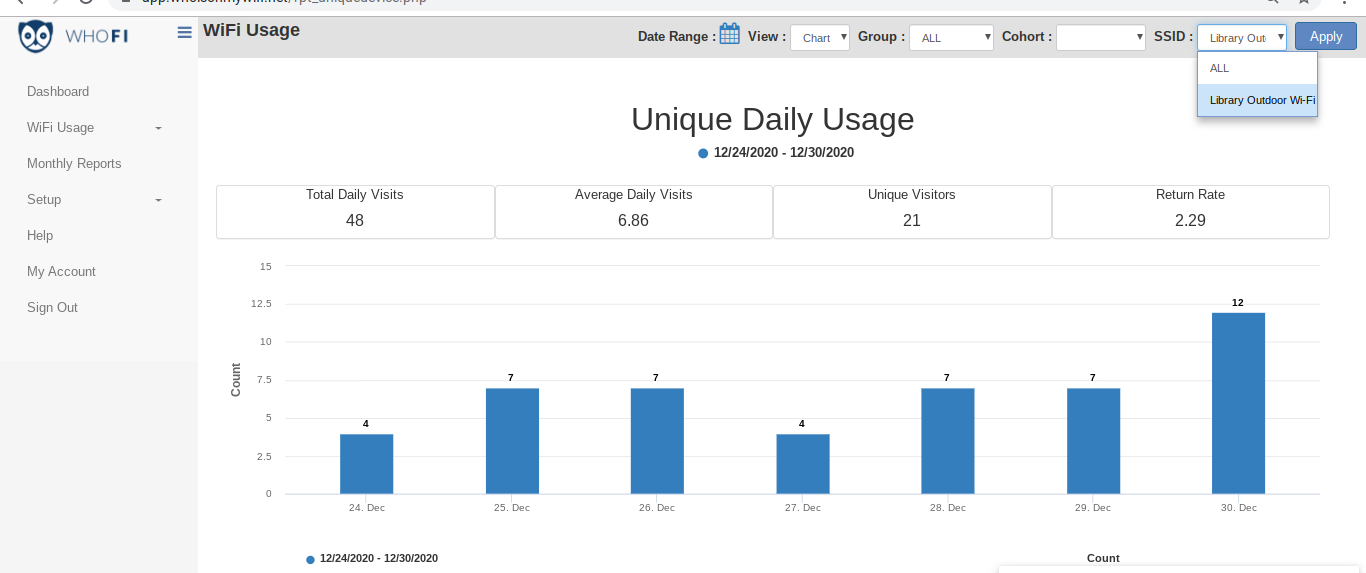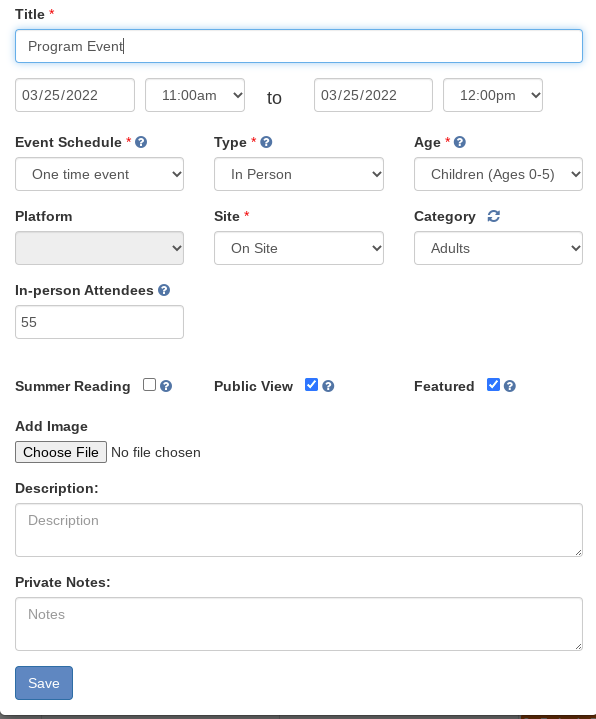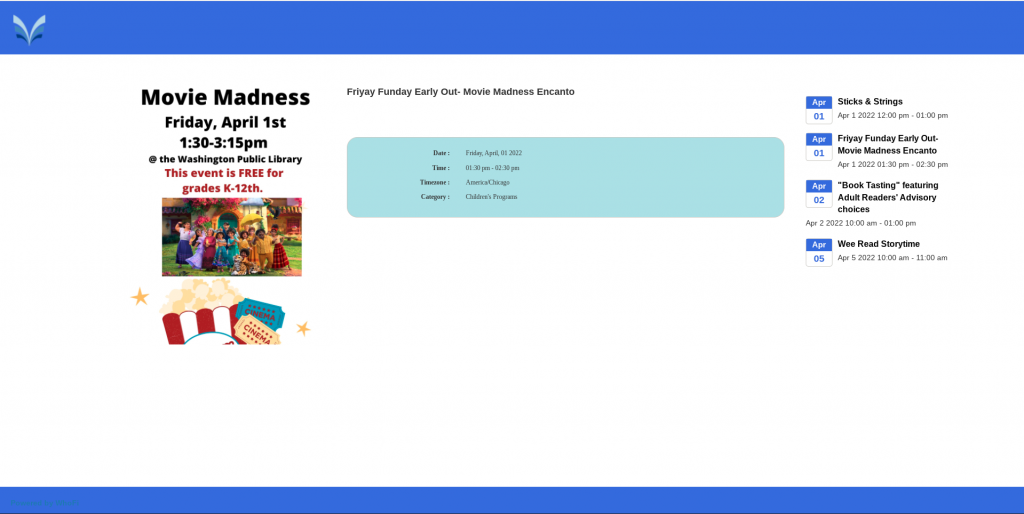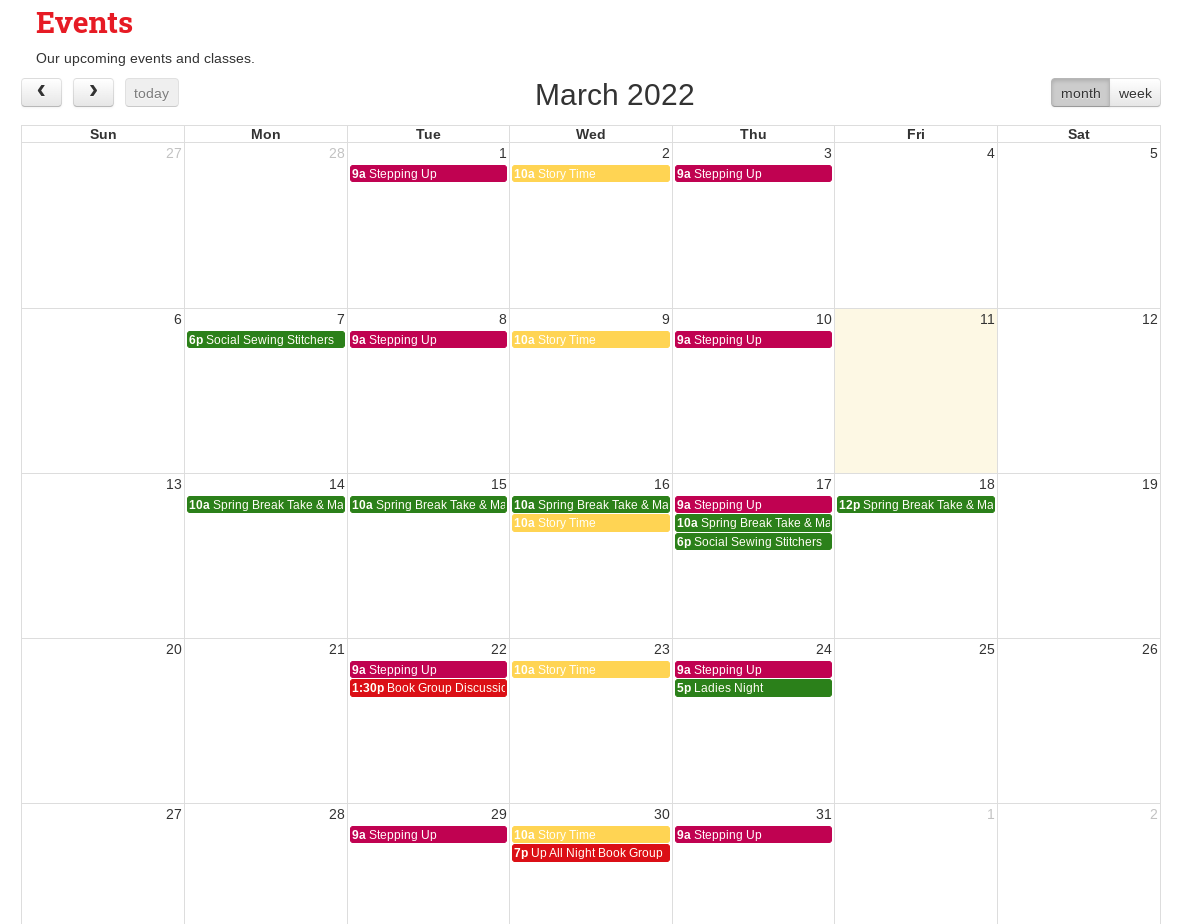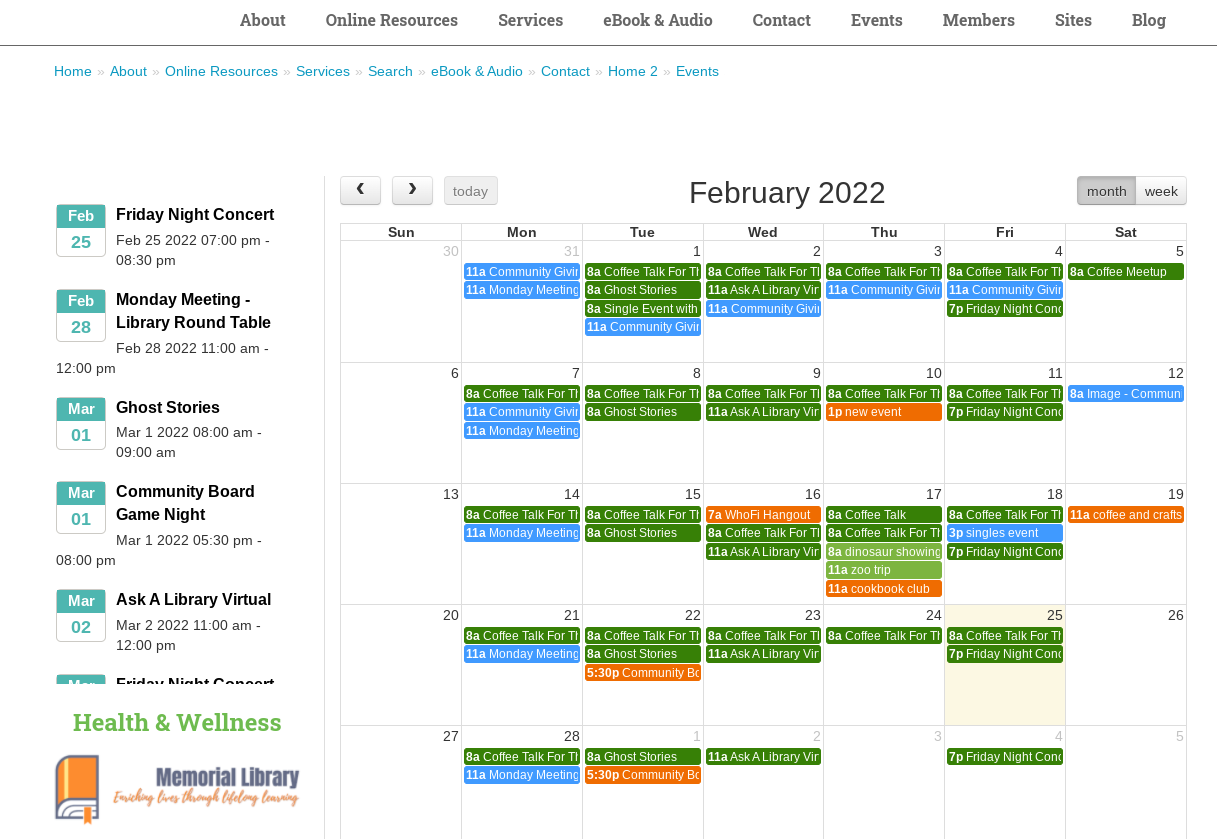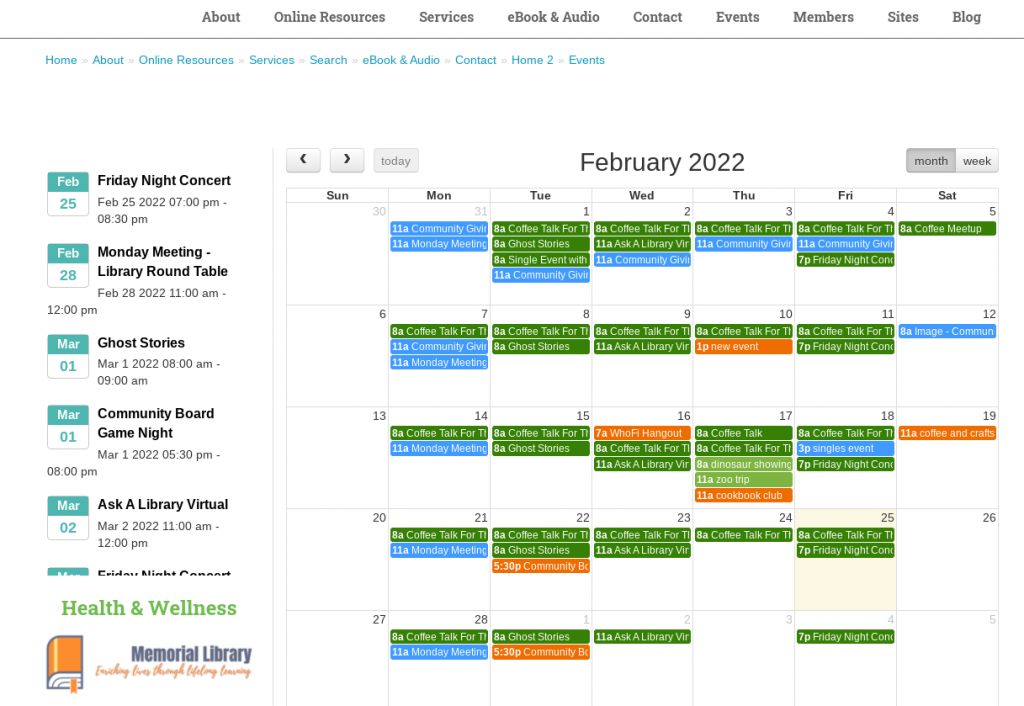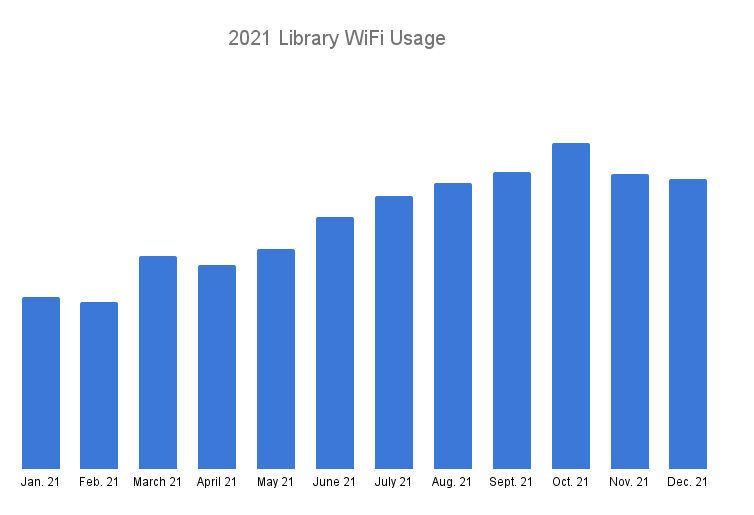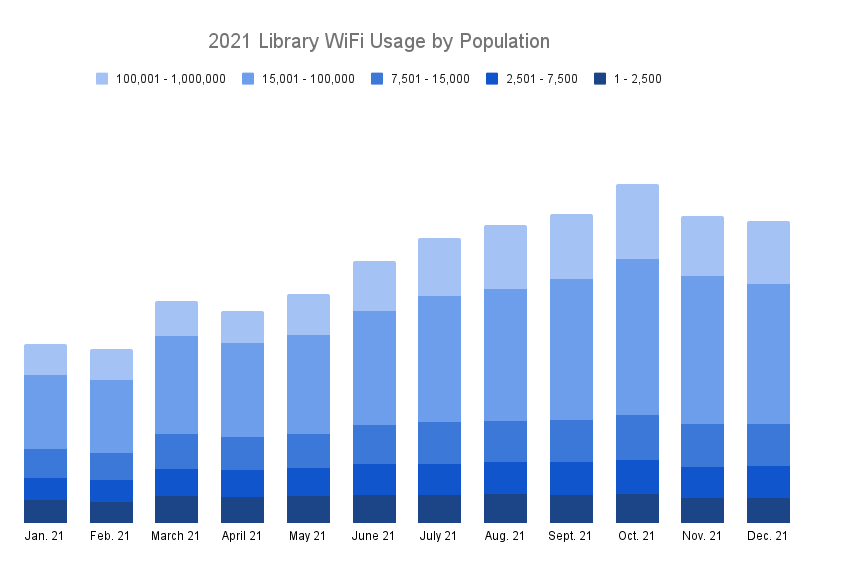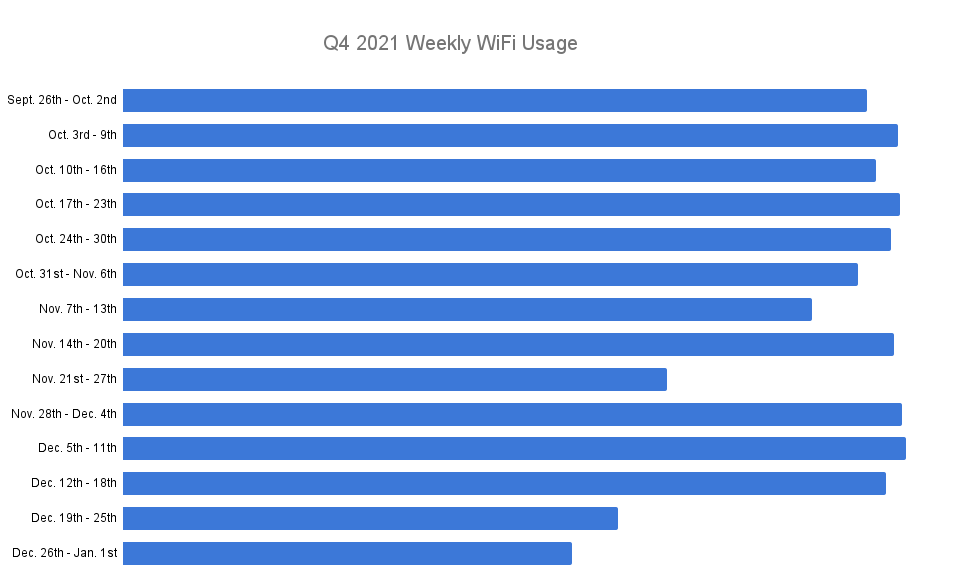How Lisa Used Data To Advocate For Her Library And Secure Grant Money
Lisa Johnson is the director of the Orange City Public Library. Like many library directors across the country, she adapted the library services when the COVID-19 pandemic hit and libraries closed their doors to the public. What became the new normal brought about new patron behaviors. She noticed patrons would often sit outside on the ground, on a ledge or in their cars to use the library WiFi.
This trend continued as the months went on. With more people needing the library’s WiFi services, Lisa knew something needed to change.
WiFi Analytics Helped Lisa Secure Funding for Library Improvements
Lisa used the WhoFi WiFi analytics system that her state purchased for libraries to identify usage trends and determine when patrons were using the library WiFi. She discovered from the WiFi analytics data that people were using the library WiFi after hours, for extended periods of time, so she made sure the WiFi was on 24/7.
Even though library doors were closed, Lisa wanted to make sure that need was met, so she used the WhoFi data to secure $5,000 in grant money. She used the grant to improve the outdoor space and strengthen the WiFi signal.
With the grant money, the library created a nice outdoor space with benches so patrons could sit comfortably and use the library’s WiFi or attend outdoor programming. Old window ledges were fixed up to create additional seating, too. Because Lisa paid attention to the changing patron behavior she was able to use the WhoFi WiFi analytics data to help her get resources to meet the community's needs. And it’s paying off! Lisa says the outdoor space is frequently busy, the WiFi usage is high, and the new outdoor space looks fantastic.
Having easy access to the WiFi data and information made it easy for Lisa to write the grant to secure funding for her library.
A New Program Tracking Tool Gives Lisa Back Valuable Time and Ensures Accurate Reporting for the PLS Survey
In addition to the change in the way libraries offer services, there was a change in the way programs are offered, too. With limited or no indoor programming available, libraries moved programs outdoors, online or both. This presented a new challenge on many levels, but one in particular was that there was not a good way to track program attendance with this new model. A hodgepodge of hand-tallying on paper and spreadsheets wasn’t cutting it.
Lisa was trying to come up with a better way to track and understand the library’s programs, which was no easy feat! With the various categories, schedules, and fluctuating attendance, old methods of hand-tallying or spreadsheets are cumbersome and inefficient. Then when Community Calendar was released to select states, Lisa jumped on the chance to implement this feature at her library.
Community Calendar was the right tool at the right time for Orange City Public Library.
Community Calendar is a reporting tool to help libraries understand their programming and better serve the community. An easy-to-use system to schedule programs and view insights – all in one place. This tool makes it easy to schedule, manage, and count attendance at all programs and events.
Lisa said that before she used Community Calendar, it took a full 40 hour work week to complete the state report. Now, she completes it in a day.
Everything is so much easier, too. Community Calendar gives libraries the tools to provide answers about in-person and online programs, defines clear categories for programs to create consistent reporting, auto-generates reports for easy end-of-year reporting, and eliminates the need for hand-tallying or complicated spreadsheets.
No more shuffling papers.
No more hand-tallying.
No more confusing spreadsheets.
If this sounds like something that you think can help your library, like it helped Lisa, schedule a demo today to learn how your library can benefit from Community Calendar.
About WhoFi
WhoFi provides libraries with wireless session counts, for advocacy, operational improvements related to the patron experience, and for the annual PLS and state surveys. To learn more about how libraries can use WiFi insights to improve patron services, schedule a demo to see how it all works.
Library Automation Software For Small Libraries
Public libraries offer great value for communities of all sizes. There's no question that the services provided are needed, but libraries may struggle to account for the community impact they have. If you’re looking for clarity on how many patrons use your services, or proving the value of the connection your library brings, you could benefit from library automation software for small libraries.
How can Library Automation Software Help My Library?
Simply put, library automation software can save you time (a lot of it), give you clarity, provide accurate and in-depth insights to help you better serve your community. WhoFi WiFi analytics is an easy-to-use and easy to install software that automatically keeps track of your library WiFi usage rates. You’ll be able to identify new visitors, return visitors, see big picture trends and day to day usage rates. Insights such as patron dwell time, session counts, and new vs. return rates are being used in strategic planning, day-to-day decision making, advocacy communications, and programming enhancements. All of these insights are provided while still respecting and maintaining patron privacy and adhering with all privacy laws.
“I’ve been waiting for a service like this for years! It’s easy to view the monthly report and I can’t believe how many sessions we were missing with previous tracking methods. I’m very happy with this technology.” Lyon County Library, Amy Geddes
What is WhoFi WiFi Analytics for Public Libraries?
WhoFi is a library automation software for small libraries designed to help libraries thrive in the digital age. WhoFi provides a cloud-based WiFi analytics reporting tool that enables libraries and other community spaces to gather and display data about WiFi usage.
WhoFi Library Edition is designed specifically to address the needs of public libraries. The system was refined with direct feedback from public libraries to determine universal definitions of metrics to create standardized reporting. In addition, the service provides the same insights regardless of the size of location or network setup. This allows for an apples to apples comparison across locations. The easy-to-use insights dashboard gives library directors the information they need to make data influenced evaluations and decisions. Other systems may provide generic data points, but are not designed specifically for the needs of public libraries, which makes them cumbersome to use. The WhoFi Library Edition creates and uses a standardized metric to generate accurate insights, other methods do not.
“The information available through the reports is great. I’m so glad the state purchased this for us. Now the board can see how the library is benefiting the community. We’re really able to show our worth.” Ashton Public Library, Tim Christianson
Small Libraries With Big Impact
Our partners report that they found they were drastically under counting their WiFi usage (by using hand tallying or guessing methods) and were surprised to find out exactly how many and how often patrons used their WiFi service. WhoFi WiFi analytics is a library software that helps small libraries collect insights by automating tasks that take your time and attention away from patrons. This helps relieve the burden and stress of gathering information and reporting by doing it for you! You can access all the information you need with just a few clicks and feel confident knowing they are accurate, standardized and easy to understand. With the WhoFi insights reports, you’ll be able to prove the value your library brings with data to back it up.
Rural public library locations report being pleasantly surprised by the amount of patron WiFi usage at their locations. Libraries with service populations under 1,000 people have proved the value of library WiFi and used these insights to advocate for additional funding to the board.
“Before WhoFi started counting our wifi use we thought only one or two patrons a year used the wifi in the library. We were stunned to find out in the first month how much our Wi-Fi was being used and still being used today. It’s easy to set-up and use. If you can use email, you can use this. We leave the WiFi on 24/7. We know that it’s being used by nearby homes, school kids sit in the parking lot or park across the street.” Valley Tell Library, Deb Gillick
WhoFi library automation software provides immense value to public libraries and their communities all while keeping patron information completely private. Schedule a demo today and see how your library can benefit from WhoFi today!
Public Library Insights Q1 of 2022
The first quarter of the year saw broad based increases in WiFi usage among all population sizes. In previous quarters, rural population areas had an increase in usage much sooner than urban areas. Then over time we saw urban areas begin to catch up with rural areas on a percentage basis.
This is the first quarter since the pandemic began that WiFi usage rates for all population areas experienced continued increases.
This could be attributed to a variety of things and events that coincide with the steady increase in WiFi usage. Libraries are fully reopened to patrons, mask mandates are dropping, vaccines are and have been widely available, and the Omicron variant surge began to subside mid January.
In fact, when we compare March 2021 to March 2022, there is a 96% increase in WiFi usage. That level of percentage increase indicates trends may be shifting to a post-pandemic "new normal."
Increase in WiFi usage among all population sizes
For the first time since the pandemic began, libraries in all population sizes are seeing WiFi usage rates get closer to their historical norm. One thing is clear and it's that the community needs the public library's WiFi and is showing up to use it and the services provided in the space.
The chart below shows just how much of an increase there's been this quarter.
Comparison monthly usage
Looking back at the previous months WiFi usage provides a good comparison for the increases we saw in February and March 2022. The graph below highlights the steady rise in February with a larger increase in March.
WiFi usage by population size
In previous reports, our data showed that library WiFi use in both urban and rural service areas decreased, but urban areas had a much greater drop. And throughout the pandemic libraries in rural areas had a much faster return to pre-pandemic WiFi usage rates compared to libraries in urban areas. Now both urban and rural libraries are seeing equally increasing rates of WiFi usage.
2021 into Q1 2022 Comparison
Looking even further back shows a story about how much higher the increase this quarter appears to be. It's always difficult to forecast, but if these trends continue, we would expect to see even higher summer numbers than are already being recorded.
What does this mean for these libraries and how can they best serve their community going forward?
The data is clear: WiFi is a valuable resource the libraries offer to help their communities. As libraries begin to prepare for the year ahead and planning for the future, tracking WiFi usage could prove beneficial for library advocacy efforts, operational improvements, strategic planning, and accurate reporting for the PLS survey. Having such information can give libraries the tools they need to secure funding to provide more and better services, and even help guide decisions on how to best use their space.
Carrying insights into the future.
This data solidifies the importance of public libraries within the communities they serve. Throughout the pandemic, public libraries continued to help patrons stay connected to school, work, and family. In addition, they also continue to help provide social service assistance for their community members through filing for unemployment, Census registration, and job searches. In a post-pandemic "new normal" we expect to see continued use of the library WiFi by the communities and the patrons that they serve.
Get Better Results and Save Time With Library Automation Software
The past two years have proven that libraries are invaluable. It’s a truth already known, and was further cemented during the Covid-19 pandemic. While libraries continue to serve communities and go above and beyond during times of crisis, their resources are stretched thin. One way to alleviate some of the workload is to automate certain tasks, like data collection. Libraries can improve their services and gain valuable insight by implementing library automation software.
How can library automation software work for your library?
The WhoFi solution works with the technology you already have which makes it easy to integrate into your current public library WiFi system. What’s even better is that it can be installed by just about anyone-no IT background required. The set-up process is easy and straightforward with minimal hands-on time required from you.
The system works quietly in the background to gather WiFi insights while you focus on serving patrons and big picture projects. All insights are gathered together in a user-friendly dashboard where you can view statistics like how many visitors you had, how long a patron uses your WiFi and how often, and other numbers you’ll need to fill out the annual PLS report.
What is WiFi analytics for public libraries?
WiFi Analytics is an automation tool that provides valuable insights about patron visits. Once installed, this technology gives you the information you need to learn more about your patrons so you can better serve them and your community.
What kinds of things can WiFi analytics library automation software do? A lot! And automatically, of course. With software downloaded to your existing hardware, you can:
- Count how many devices are connected to your WiFi
- Determine how long patrons stay at the library
- identify when a new patron visits the library
- Identify how frequently a patron returns to the library
- Differentiate recurring vs. new visits
- Determine if a patron visit coordinates with a particular event
- Learn more about visitor demographics
All of this valuable insight can be gained while maintaining visitor privacy by using a one-way encryption method. This allows libraries to see large scale trends of visitor behavior and patterns without compromising trust or identities. Library automation software like WhoFi - WiFi analytics gives you the tools you need so you can make data-driven decisions while maintaining visitor anonymity.
Benefits of WiFi analytics
- Help decision makers understand how patrons are using the library
- Provide a big picture view of library program and outreach success
- Identify how, when and how frequently patrons use the library WiFi and other technology
- Free up more time for library staff to focus on larger projects
- Provides in-depth information and easy-to-understand reports for directors and boards
- Saves a lot of time filling out PLS reports
- Ensures accurate reporting
- Creates standardized metrics
WhoFi library automation software provides immense value to public libraries and their communities all while keeping patron information completely private.
Schedule a demo today and see how your library can benefit from WhoFi today!
Community Calendar Branding Customization
The Community Calendar features just keep getting better! Community Calendar was developed because our library partners wanted a way to create events once and publish directly to their library website. This would eliminate the need for multiple entry of events and free up valuable time.
Now, your Community Calendar integrates directly with your website and you can customize it for your own branding.
First, email our support team at support@whofi.com to let us know you want to create your Community Calendar. We’ll set up the iFrame for you, and you’ll get a notification once it’s complete. Then within your account dashboard, you can find HMTL code that you’ll copy and paste into your website directly. Once that’s done the calendar integration should be complete and live on your website.
You can easily create events and publish them directly to your new Community Calendar that’s integrated into your website. The Community Calendar allows you to create one-time or recurring events and has prepopulated categories that match what you’ll need for the PLS.
And now you can even customize your Community Calendar branding!
Make your calendar integration even more seamless by customizing it to fit your library branding (images, colors, logos). We’ve made it easy to set up so you can select your library colors, quickly upload your logo, and update any images. Since the Community Calendar iFrame is already set up for you, all you need to do is make a few selections to customize the appearance, click save, and you’re done!
Organize events with color coding
You can improve the appearance of your Community Calendar by color coding events so recurring events or particular categories have the same color. All you have to do is add a category, give it a name and choose a color that you would like it to appear. This makes it easier for patrons to identify which events they want to attend.
Easy set-up and support
Your WhoFi team works with you to ensure the setup process goes smoothly and is here to answer any questions you may have. Partners will also have access to tutorial videos as you’re learning how to use your Community Calendar. It can be helpful to watch a video, pause it, and then implement what you learned. And of course, you can reach out to the support team at support@whofi.com
WhoFi Announces Launch of New Community Calendar Service To Help Libraries Streamline Program Management
WhoFi announces the launch of its new service, Community Calendar, to help libraries streamline the many aspects of programming. Community Calendar is an all-in-one library program planner that makes it easy to plan, track, and report on programs for the Public Library Survey. It also simplifies the promotional aspects of notifying patrons of future events. This is done by publishing programs directly from the Community Calendar to the libraries’ websites. There is no longer a need for libraries to manage multiple calendars and spreadsheets related to programming. Community Calendar will be available to all customers beginning March 9th, 2022.
Since the onset of COVID-19, many libraries have migrated their in-person programming to online. Now that many have reopened, they are offering a mix of online and in-person programs, but don’t have a streamlined and effective tool to keep track of it all. Community Calendar makes it easy to schedule, manage, and track programs and attendance at all library-hosted events ― a task currently done by hand tallying and over several spreadsheets.
“The Community Calendar feature is wonderful for tracking library programs! Before this, I spent a full 40-hour week doing the PLS reports. Now, it only takes a day." said Lisa Johnson, Orange City Public Library Director.
Library staff can easily create one-time or recurring events from within their Community Calendar dashboard. With a few clicks, they can plan their week, month, or year. Attendance is counted for each event and populated into an easy-to-read report with comparisons available for various categories. Library staff can enter the program’s targeted age group, site, type, category, platform, and other relevant information directly into the calendar tool to be used for future reporting. Since many libraries are posting online events to their social media accounts for patron viewing, we added a feature that allows libraries to account for views to recorded programs as well.
Libraries can also integrate their Community Calendar directly onto their website which eliminates the need for double entry (to the website and community calendar), while separately keeping track of those same programs in a spreadsheet for reporting purposes. Librarians these days do more with less people, and having everything in one place saves time and stress.
The Community Calendar feature has been piloted by public libraries that previously made WhoFi aware of the administrative burden throughout the programming process. Their feedback was used to ensure this new service offering met the specific needs of public libraries. Now, the Community Calendar is ready for launch for all public libraries.
WhoFi offers services to help real-word spaces understand and engage with their patrons within the building and beyond. For more information about WhoFi or the Community Calendar, visit whofi.com
Publish Library Events To Your Website With Community Calendar
Scheduling and publishing your library’s events is getting much easier! Now you can streamline your event planning processes and eliminate double entry with the WhoFi Community Calendar website integration — a new feature that allows you to publish events from your WhoFi Community Calendar dashboard directly to your library’s public facing websites.
Website Integrations are now generally available for WhoFi customers using the Community Calendar tool.
Integrate the Community Calendar onto your Website
Integration Saves Time
This tool makes it easy to schedule, manage, publish and count attendance at all programs and events, both in-person and online. It eliminates the need for double entry. You no longer need to keep track of programs on an excel sheet or in the community calendar, and then also remember to add your programs and events to the website. The integration pushes all of your programs to your website for you!
You can integrate onto your website using a simple link or iframe for a more onsite experience for patrons.
Integration Keeps Patrons Engaged
Community Calendar website integration also helps keep your patrons aware of what programs are happening at the library. You're already doing the work to host the programs, track which ones were done, and how many people attended. Why not also let patrons easily know what programs are happening at the library? Showing your programming on your website becomes a great place for patrons to know what community events are happening that they might be interested in.
Some of our library partners have already started using Community Calendar. Lola, director for Pocahontas Public Library, loves that Community Calendar has preset categories that match what’s required for the PLS survey. It’s so simple and easy and saves her tons of time. Not to mention she can be sure she has accurate data for the PLS report and for internal planning purposes. Read more about how Community Calendar helped Lola here.
How can Community Calendar help you?
- Makes it easy for you to schedule and publish program calendars to your library’s website.
- Create events once from within your user dashboard
- Events publish to your website, including recurring events
- Gives you the tools to provide answers about program attendance, both in-person and online.
- Defines clear categories for programs to create consistent reporting.
- Alleviates the need for hand-tallying and storing numbers on paper.
- Auto-generates reports for easy end-of-year reporting - no more complicated spreadsheets and calculators - we do it for you!
- Saves you time on PLS reports.
Community Calendar gives your library everything you need for online and in person programming. Check out these additional resources and partner stories about how Community Calendar helped them. Contact our support team if you have any questions.
2021 Annual Analysis of Public Library WiFi Usage
WhoFi analyzed data from our library partners to identify WiFi usage trends. This report includes our findings for 2021.
Public Library Insights for 2021
When analyzing WiFi insights data and looking for usage trends over the past year, we’ve identified clear fluctuations in use that seem to correlate with particular service areas, important timelines in the pandemic, and/or library outreach efforts. As we look at the data for 2021, there are some interesting changes to these numbers, along with a steady increase in WiFi usage across service areas.
The COVID-19 pandemic certainly brought about many changes in the way patrons interact with their libraries and how libraries serve their communities. These changes seem to be contributing to the WiFi usage trends, as many libraries have extended their WiFi services by leaving it on 24/7 and creating stronger signals for patrons who use WiFi in the parking lot.
With the pandemic continuing as libraries adjust to having both in-person and virtual programs, as well as opening the doors to patrons for sit-and-stay WiFi use, what does WiFi usage look like in 2021? In 2021, there continues to be a steady increase and at a much higher usage rate which means more patrons are using the WiFi this year. The graph below shows the total national WiFi usage for 2021.
Why are more people using the library’s WiFi now?
In our last report we noted that there was a new higher WiFi usage trend that appeared to start in March 2021 and continues to keep a steady pace of growth. This could be related to vaccinations being deployed, reopenings, and libraries continuing to enhance efforts to extend WiFi services. Historically, libraries have had higher WiFi usage in warmer weather, and this is true this year. Interestingly, October was the highest usage month, with a slight dip during the holiday season, as expected. One thing is clear and it's that the community needs the public library's WiFi and is showing up to use it and the services provided in the space.
How does WiFi usage by population size stack up?
In previous reports, our data showed that library WiFi use in both urban and rural service areas decreased, but urban areas had a much greater drop. And throughout the pandemic libraries in rural areas had a much faster return to pre-pandemic WiFi usage rates compared to libraries in urban areas.
The urban libraries have seen a much higher percentage increase in WiFi use for 2021 as a whole, compared to rural areas. This could be attributed to the fact that rural areas had already regained their usage rates and urban areas are now catching up. The graph below show the WiFi usage rates by population for the entire year.
Q4 weekly usage
Looking at the dip in November and December in WiFi usage, we decided to dig deeper to see what might be accounting for this. We usually find a dip in November and December of most years. Looking at the WiFi usage trends on a weekly basis provided insight into what's happening. As you can clearly see from the weekly chart below, the holiday weeks of Thanksgiving, Christmas, and New Years correspond with significant decreases. This helps to explain the seasonality of the monthly decrease that happens in November and December.
What does this mean for these libraries and how can they best serve their community going forward?
The data is clear: WiFi is a valuable resource the libraries offer to help their communities. As libraries begin to prepare for the year ahead and planning for the future, tracking WiFi usage could prove beneficial for library advocacy efforts, operational improvements, strategic planning, and accurate reporting for the PLS survey. Having such information can give libraries the tools they need to secure funding to provide more and better services, and even help guide decisions on how to best use their space.
Carrying insights into the future.
This data solidifies the importance of public libraries within the communities they serve. Even before the coronavirus outbreak, lack of internet access was a big problem – now it’s critical. Throughout the pandemic, public libraries have continued to help patrons stay connected to school, work, and family. In addition, they continue to help provide social service assistance for their community members through filing for unemployment, Census registration, and job searches.
The knowledge we’ve gained from WiFi insights will continue to influence how libraries interact with the communities they serve.
WiFi Analytics Gave Brenda Tools To Help Patrons
Brenda Miller is the director of New Madison Public Library. The pandemic changed the way her library’s patrons interacted with the library and used its resources. Before COVID-19 caused the library to close its doors, patrons would come into the library building to sit and use the free WiFi, browse books, enjoy children’s programming or just have a safe place to hang out.
So when the library doors closed because of the pandemic, Brenda noticed different patron behavior, like outdoor and after hours WiFi use. Brenda kept her library’s WiFi on so patrons could still use it while outside. And they did. People would sit outside of the library with their laptops to use the WiFi, or sit in their cars in the parking lot.
Brenda used the WhoFi WiFi analytics system that her state purchased for libraries to identify usage trends and determine when patrons were using the library WiFi, how often and for how long. Another new trend she discovered from the WiFi analytics data was that people were using the library WiFi after hours. So even though library doors were closed, patrons still needed the library’s resources and help, and Brenda was determined to make sure that need was met.
WiFi Data Backs Up Local Experiences
Brenda used the information provided with the WiFi analytics to provide concrete data to the library board to back up the decision to purchase stronger broadband and extend the WiFi signal. This allowed her library to strengthen the WiFi and extend the signal so more people could use it while sitting outside the library or in the parking lot. She knew the library needed to provide more robust WiFi, particularly during the height of the pandemic, and having numbers to prove that this was necessary reinforced the value of this library service.
As librarians across the country had similar experiences with patron behavior, the WhoFi team noticed trends among all library partners as well. So we compiled all of the data and produced a quarterly report for all libraries throughout the pandemic. Brenda said these reports were particularly helpful since she could see large scale trends that reflected what she experienced locally. She shared the quarterly reports with the board so they, too, could feel comfortable knowing that their local library is making the best decisions for their particular community and their experience is shared among libraries across the country.
Local Stories Make It All The Way To The Governor
Over time, Brenda started to recognize people who would frequent the library parking lot to use the WiFi. One of the regulars was a local high school student who came to the library every day to use the WiFi from the parking lot to participate in remote classes and do homework. There’s plenty of stories like this across communities. This is a real life example that highlights the need for adequate funding for stronger library WiFi.
Brenda shared this story, and other patrons using library WiFi from the parking lot, with her state directors and the story made it all the way to the governor. Many people in the community can’t get WiFi at home sufficient for remote learning and coursework, and they rely on the library to provide this essential service. Sharing stories and experiences matters as the news travels to decision makers, but having data to back it up makes it even more compelling.
Making Data-influenced Decisions To Help Patrons
Brenda adapted her library’s service offerings to the new normal, which was providing services from a distance, rather than in-person. She found ways to offer services, like free WiFi, and maintain the community connections while following COVID safety protocols. The WhoFi WiFi analytics program gave her the insight and confidence to make decisions that would help patrons during a crisis, and everyday thereafter.
About WhoFi
WhoFi provides libraries with wireless session counts, for advocacy, operational improvements related to the patron experience, and for the annual PLS and state surveys. To learn more about how libraries can use WiFi insights to improve patron services, schedule a demo to see how it all works.
How Community Calendar Helped Lola
Lola DeWall is the library director for Pocahontas Public Library. The pandemic transformed the way her library, like many across the country, offered programming. Before March 2020, Pocahontas Public Library offered in-person programming and got by using old methods of tracking attendance like hand tallying on paper. That method of tracking program attendance was already arduous and time consuming, and with all of the upheaval the pandemic caused, it quickly became very difficult to keep up.
Lola kept track of all her library programs on paper, which meant she had to hand tally each participant for each program on a piece of paper. Then, she went back and added up all of the participants for each group of programs, like children’s story time or adult programs, and kept all of the pieces of paper stored in a file. Since everything was done by hand with pen and paper, she had to create her own categories for the programs her library was offering and then group things by these categories. This was a time consuming and tedious task that took time away from other big picture projects.
One major drawback of the hand tallying paper method (other than it takes so much time) is that there is no way to see historical trends, helpful graphs or a way to organize numbers. She knew this old method wasn’t going to work for them and she needed a new solution, fast.
The Right Solution at the Right Time
Lola had been using the WhoFi WiFi analytics program that her state provided to its libraries, and a new feature recently became available that showed her a simpler way to track programs. It was the solution she was looking for and she took advantage of the feature right away.
Community Calendar is an all-in-one library program planner that streamlines program calendars and makes it easy to report program attendance for the Public Library Survey. Community Calendar is designed to help libraries plan and monitor both their online and in-person programming attendance. It is also used to help grow the community and increase patron engagement by making programming more visible.
She started to use the Community Calendar feature at her library to help plan, manage and track program attendance. Since the Community Calendar already has every category and program type needed for the PLS report, all Lola needed to do was count attendance and enter the total number into the specific program within the dashboard. That’s it! Counting, reporting, and organizing the programs was already done for her.
Easy Integration and Happy Partners
Lola loves that Community Calendar has preset categories that match what’s required for the PLS survey. It’s so simple and easy and saves her tons of time. Not to mention she can be sure she has accurate data for the PLS report and for internal planning purposes.
She loves how simple and easy it is to use and that the WhoFi programs constantly adapt to what libraries need based on feedback. She’s even told other libraries in her area about it!
COVID Created a Problem That Needed a Good Solution
Librarians adapted their programs to the new normal, which was finding connections online, rather than in-person. They found ways to translate their in-person programs to the digital space to keep patrons engaged, offer support, and maintain their community connections while following COVID safety protocols.
And it worked!
The evergreen ingenuity and adaptability of libraries and swift response to community needs created new challenges with online and in-person program planning and attendance tracking. Library programming was changing fast, and there wasn’t an efficient or effective way to track online or outdoor programs. They needed a solution, and now there is one in Community Calendar.
The biggest benefit of Community Calendar is that it gives you back more time, assures accurate reporting, and fits exactly with what you need to fill out the PLS survey.
If this sounds like something that you think can help your library, schedule a demo today and see how your library can benefit from Community Calendar.



